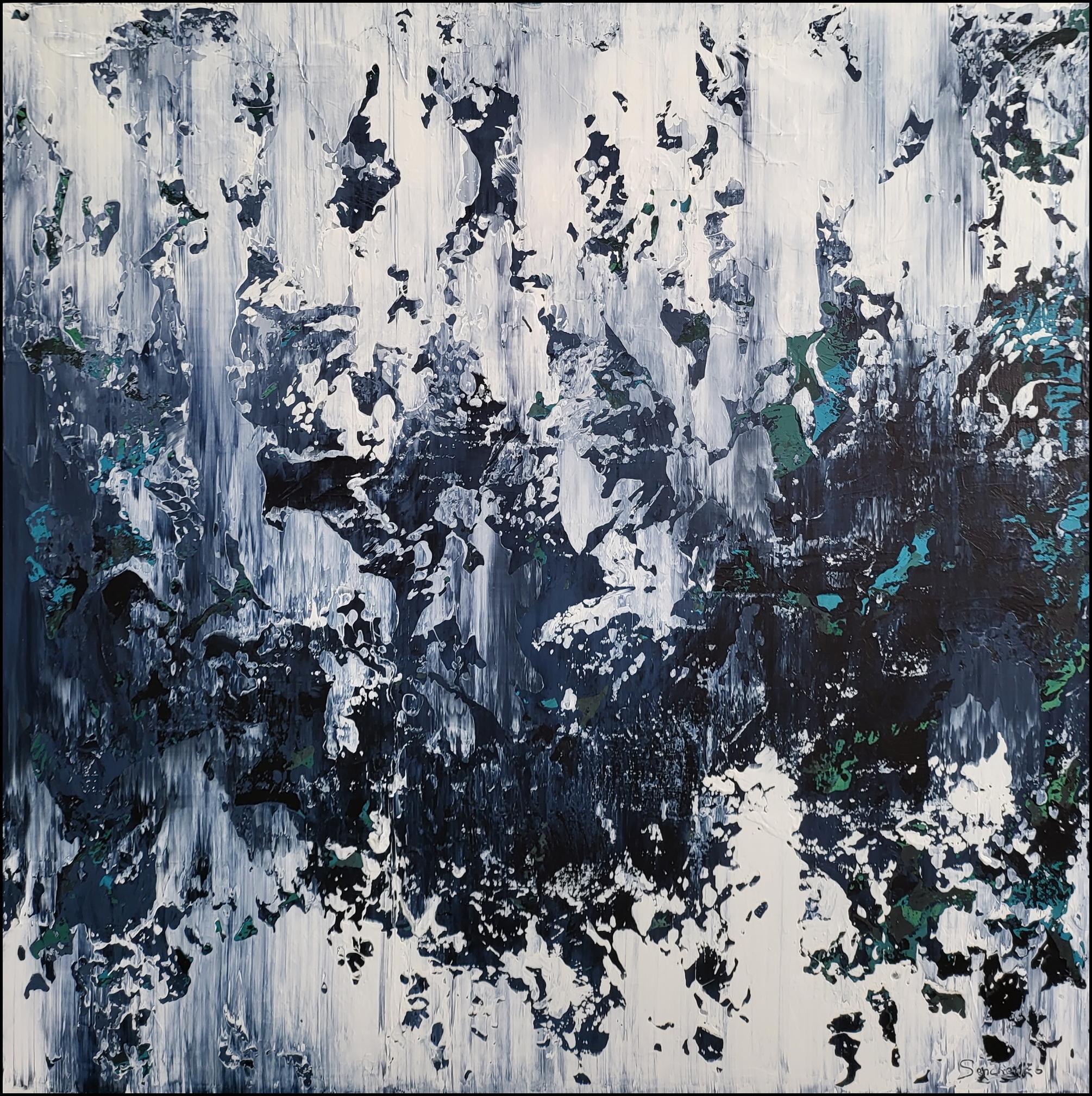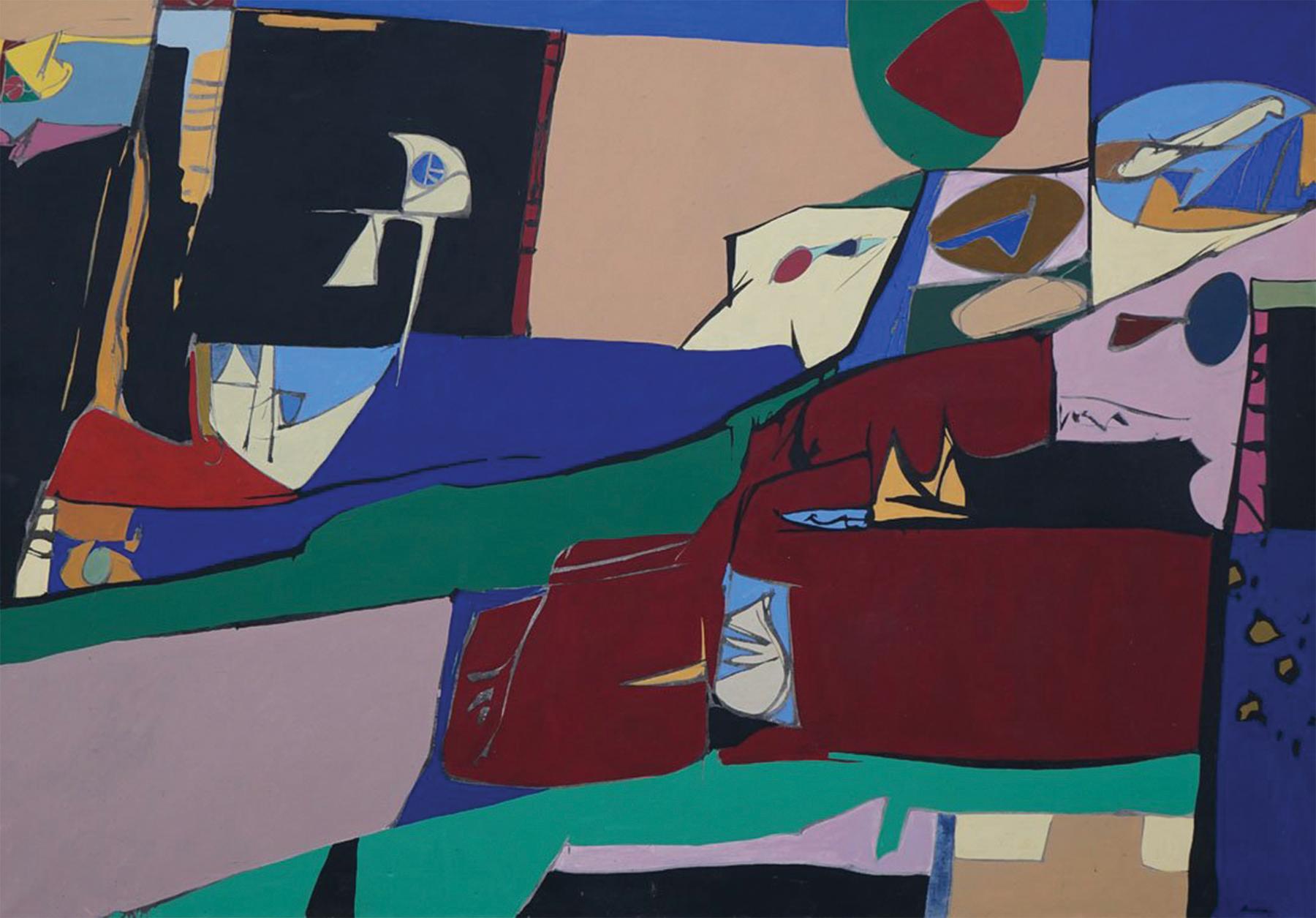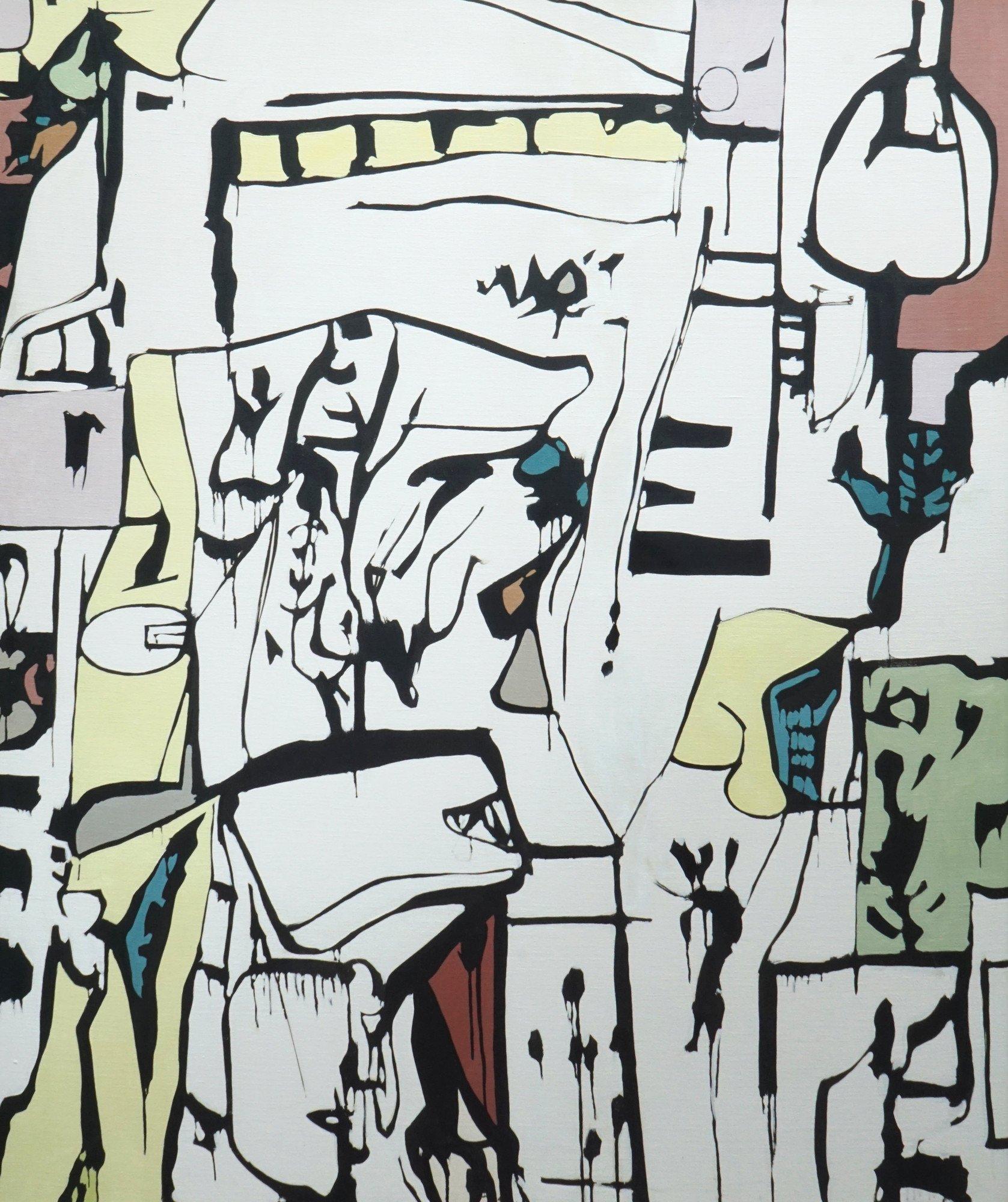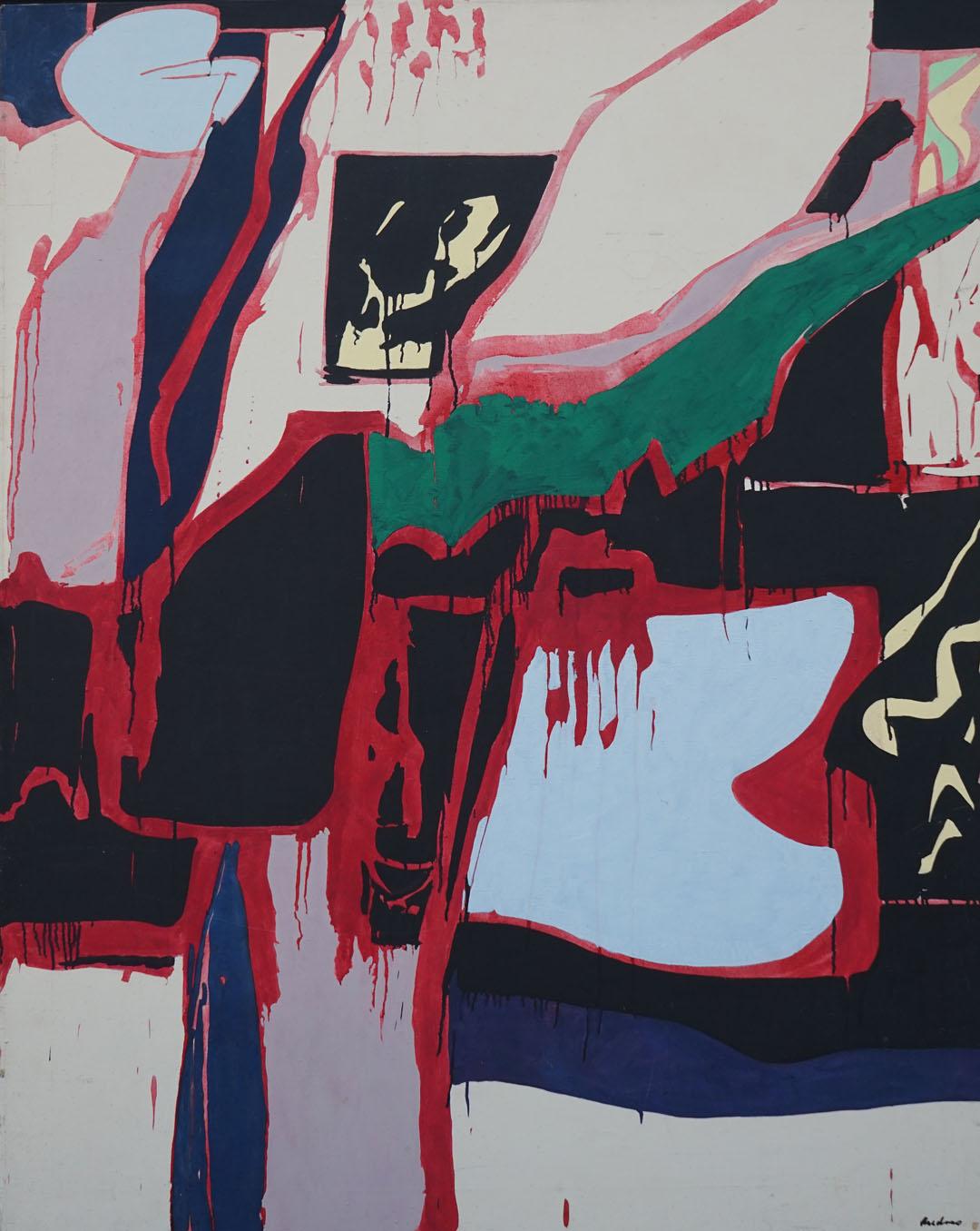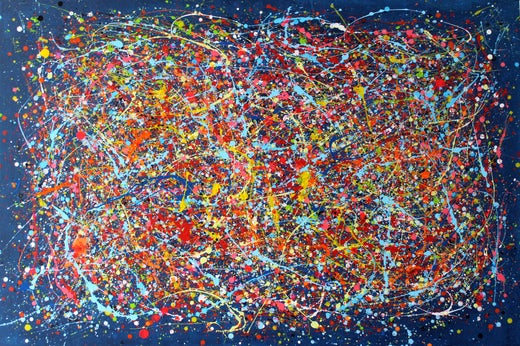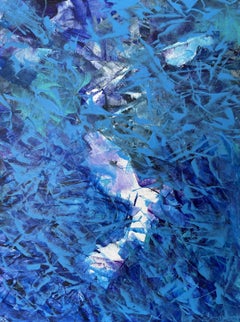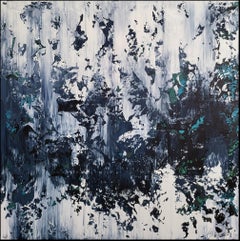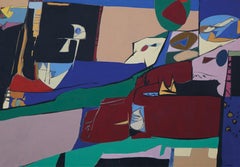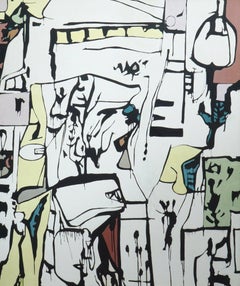Items Similar to Love yourself It's free
Video Loading
Want more images or videos?
Request additional images or videos from the seller
1 of 21
Juan Jose GarayLove yourself It's free2021
2021
About the Item
Painting: Acrylic The dance of colors generates a scene of great beauty. The strength of the movement and the shapes created with its colors convey a dream towards realities that touch the deepest feelings of the viewer. The plastic work of Juan José Garay, framed within the abstract line, supposes a meeting of memories and inspirations of various kinds that, emerging from his mind, becomes reflected in the pictorial support through the formation of almost impossible spaces. Through a technique that combines acrylic, oil and enamel, its ultimate goal is to establish a dialogue between the abstract and feelings, generating a symbiosis between will and chance as drivers of genius. All works are original and have a certificate of authenticity signed by the artist. The works are in perfect condition and will be sent directly from the artist's studio.
- Creator:Juan Jose Garay (1970, Spanish)
- Creation Year:2021
- Dimensions:Height: 39.38 in (100 cm)Width: 57.09 in (145 cm)Depth: 1.19 in (3 cm)
- Medium:
- Movement & Style:
- Period:
- Condition:
- Gallery Location:LAS ROZAS DE MADRID, ES
- Reference Number:1stDibs: LU2408215373492
Juan Jose Garay
Juan José Garay es un artista plástico español nacido en 1970, conocido por su estilo en la técnica abstracta y la pintura en movimiento. Desde joven mostró un gran interés por el arte y la creatividad, lo que lo llevó a estudiar con grandes maestros como Amadeo Roca para su ingreso en Bellas Artes en la Universidad Complutense de Madrid. Durante su formación, Garay se sintió atraído por el arte abstracto y comenzó a experimentar con técnicas de pintura en movimiento. Estas técnicas, que involucran el uso de movimientos corporales para crear gestos y trazos en la pintura, se convirtieron en una parte integral de su estilo artístico único.
Juan Jose Garay comenzó a exhibir su obra en galerías de arte y Centros Culturales de España y Europa. Su estilo abstracto y dinámico se hizo rápidamente popular entre los amantes del arte contemporáneo, y sus obras comenzaron a ser reconocidas por su originalidad y belleza.
Además de la pintura, Garay también se ha dedicado a colaborar con arquitectos y diseñadores de interiores para crear piezas de arte que complementan el ambiente en el que se encuentran.
Su obra también ha sido adquirida por coleccionistas privados y museos de todo el mundo.
En resumen, Juan José Garay es un artista plástico español cuyo estilo se caracteriza por la técnica abstracta y la pintura en movimiento. Su obra ha sido reconocida por su originalidad y belleza, y se ha exhibido en galerías y museos de todo el mundo.
About the Seller
5.0
Vetted Professional Seller
Every seller passes strict standards for authenticity and reliability
1stDibs seller since 2023
11 sales on 1stDibs
- ShippingRetrieving quote...Shipping from: LAS ROZAS DE MADRID, Spain
- Return Policy
Authenticity Guarantee
In the unlikely event there’s an issue with an item’s authenticity, contact us within 1 year for a full refund. DetailsMoney-Back Guarantee
If your item is not as described, is damaged in transit, or does not arrive, contact us within 7 days for a full refund. Details24-Hour Cancellation
You have a 24-hour grace period in which to reconsider your purchase, with no questions asked.Vetted Professional Sellers
Our world-class sellers must adhere to strict standards for service and quality, maintaining the integrity of our listings.Price-Match Guarantee
If you find that a seller listed the same item for a lower price elsewhere, we’ll match it.Trusted Global Delivery
Our best-in-class carrier network provides specialized shipping options worldwide, including custom delivery.More From This Seller
View AllImagine is Real 20
By Juan Jose Garay
Located in LAS ROZAS DE MADRID, ES
A painting in abstract acrylic is an explosion of shapes, textures, and colors that invite personal interpretation. Across the canvas, dynamic and free brushstrokes intertwine, creat...
Category
21st Century and Contemporary Abstract Expressionist Interior Paintings
Materials
Acrylic
Imagine is Real 23
By Juan Jose Garay
Located in LAS ROZAS DE MADRID, ES
A painting in abstract acrylic is an explosion of shapes, textures, and colors that invite personal interpretation. Across the canvas, dynamic and free brushstrokes intertwine, creat...
Category
21st Century and Contemporary Abstract Expressionist Interior Paintings
Materials
Acrylic
Imagine is Real 21
By Juan Jose Garay
Located in LAS ROZAS DE MADRID, ES
A painting in abstract acrylic is an explosion of shapes, textures, and colors that invite personal interpretation. Across the canvas, dynamic and free brushstrokes intertwine, creat...
Category
21st Century and Contemporary Abstract Expressionist Interior Paintings
Materials
Acrylic
Imagine is Real 25
By Juan Jose Garay
Located in LAS ROZAS DE MADRID, ES
A painting in abstract acrylic is an explosion of shapes, textures, and colors that invite personal interpretation. Across the canvas, dynamic and free brushstrokes intertwine, creat...
Category
21st Century and Contemporary Abstract Expressionist Interior Paintings
Materials
Acrylic
Imagine is Real 24
By Juan Jose Garay
Located in LAS ROZAS DE MADRID, ES
A painting in abstract acrylic is an explosion of shapes, textures, and colors that invite personal interpretation. Across the canvas, dynamic and free brushstrokes intertwine, creat...
Category
21st Century and Contemporary Abstract Expressionist Interior Paintings
Materials
Acrylic
Imagine is Real 22
By Juan Jose Garay
Located in LAS ROZAS DE MADRID, ES
A painting in abstract acrylic is an explosion of shapes, textures, and colors that invite personal interpretation. Across the canvas, dynamic and free brushstrokes intertwine, creat...
Category
21st Century and Contemporary Abstract Expressionist Interior Paintings
Materials
Acrylic
You May Also Like
Abstract 2325
Located in Zofingen, AG
There’s something different about the homes of creative people. They like to surround themselves with inspiring things, from unique tablecloths to the incredible paintings on the wal...
Category
2010s Abstract Expressionist Abstract Paintings
Materials
Acrylic
Abstract 2306
Located in Zofingen, AG
Artist : Alex Senchenko © 2023
Title: Abstract 2306
47" x 39" ( 120cm. x 100cm. )
Professional Gallery Canvas, Acrylic Paints
Original Painting on...
Category
2010s Abstract Expressionist Abstract Paintings
Materials
Acrylic
Erie Shore, Large Abstract Expressionist Mid-Century Modern geometric work
By Richard Andres
Located in Beachwood, OH
Richard Andres (American, 1927-2013)
Erie Shore, c. 1975
acrylic on canvas
signed lower right, signed and titled verso
50 x 72 inches
Richard Andres was born in Buffalo, New York in 1927. A graduate of the Cleveland Institute of Art in 1950, he was immediately drafted and served for two years in the army as a mural painter. He received his Master of Arts from Kent State in 1961. A frequent exhibitor at galleries and museums and winner of multiple May Show prizes, Andres taught art in the Cleveland Public Schools for 28 years, as well as teaching the University of Buffalo, the Cleveland Institute of Art and the Western Reserve University.
Very little in Richard Andres’ childhood would have predicted his love of classical music, mid-century-modern architecture and certainly not his lifelong passion for art and in particular abstract art. Richard’s father, Raymond, had no more than a third-grade education, and his mother, Clara, was one of thirteen children – only three of whom lived into adulthood and none of whom attended high school.
They lived, when Richard was a boy, in a dingy area of Buffalo, NY in a walk-up apartment situated above a tavern. Raymond and Clara supplemented the income from their factory jobs in the bar downstairs with Raymond playing ragtime on the piano and Clara serving drinks. This often left Richard and his two older brothers at home alone to fend for themselves. The two older boys, Raymond and Russell, were - unlike Richard- rather rough and tumble and entertained themselves with stickball, boxing and the like. Richard, on the other hand, from a very young age liked to draw, or better yet even, to paint with the small set of watercolors he received for Christmas one year. Paper, however, at the height of the depression, was hard to come by. Luckily, Clara used paper doilies as decoration for the apartment and Richard would contentedly paint and then cut up doilies, gluing the pieces together to create collages.
At eight-years-old, he discovered the Albright-Knox Museum (then known as the Albright Art Gallery) and spent several hours a week there studying the paintings. He was particularly fond of Charles Burchfield‘s landscapes, enamored with their ‘messiness’ and thinking that they somehow captured more ‘feeling’ than works he was previously familiar with. For his tenth Christmas, he asked for and received a ‘how-to’ paint book by Elliot O’Hare. Through this self-teaching, he assembled the portfolio needed for acceptance to Buffalo Technical High School where he studied Advertising Arts. In his Junior year, he was encouraged to enter a watercolor painting, “Two Barns,” in the national 1944-45 Ingersoll Art Award Contest and was one of twelve grand prize winners – each one winning one hundred dollars. More importantly the painting was exhibited at the Carnegie Institute Galleries, which resulted in his winning a national scholarship to the Cleveland School of Art (The Cleveland Art Institute).
He flourished at the art school under the tutelage of faculty members such as Carl Gaertner, as well as that of visiting artists such as William Sommer and Henry George Keller. He would say in later years that Gaertner, in particular, influenced his attitude toward life as well as art. “Gaertner,” Andres said, “believed that there was no need to be a ‘tortured artist’, that an artist should rather enjoy beauty, family, and life in general.” Free to spend his days as he chose, he wandered the Cleveland Art Museum for most of the hours he was not attending classes or painting; the remaining time was spent drinking coffee at a local hangout with art school friends – which is where he met fellow Henry Keller scholarship winner, Avis Johnson. Richard was immediately smitten with Avis, but being rather shy, it took him the entire summer of 1948 to build up his courage to ask her out. Over that summer he ‘thought about Avis’ and worked in a diner to save money. He also used the hundred-dollar prize money won in High School to visit the first Max Beckmann retrospective in the United States at the City Art Museum in St. Louis. Over a half century later he spoke of that exhibit with a reverence usually reserved for spiritual matters, “I walked in and it was like nothing I had ever seen before... the color...It just glowed.”
Returning to campus in the Fall, the first thing he did was go to the coffee shop in hopes of finding Avis. He did, and she, upon seeing him, realized that she was also smitten with him. They quickly became known as ‘the couple’ on campus, and a year later, with Richard being drafted for the Korean war, they were quickly married by a Justice of the Peace, celebrating after with family at Avis’s Cleveland home. As a gift, faculty member John Paul Miller...
Category
1970s Abstract Expressionist Abstract Paintings
Materials
Acrylic
Garden, Abstract Expressionist Mid-Century Modern geometric work
By Richard Andres
Located in Beachwood, OH
Richard Andres (American, 1927-2013)
Garden, 1972
acrylic on canvas
signed, dated and titled verso
59.5 x 50 inches
Richard Andres was born in Buffalo, New York in 1927. A graduate of the Cleveland Institute of Art in 1950, he was immediately drafted and served for two years in the army as a mural painter. He received his Master of Arts from Kent State in 1961. A frequent exhibitor at galleries and museums and winner of multiple May Show prizes, Andres taught art in the Cleveland Public Schools for 28 years, as well as teaching the University of Buffalo, the Cleveland Institute of Art and the Western Reserve University.
Very little in Richard Andres’ childhood would have predicted his love of classical music, mid-century-modern architecture and certainly not his lifelong passion for art and in particular abstract art. Richard’s father, Raymond, had no more than a third-grade education, and his mother, Clara, was one of thirteen children – only three of whom lived into adulthood and none of whom attended high school.
They lived, when Richard was a boy, in a dingy area of Buffalo, NY in a walk-up apartment situated above a tavern. Raymond and Clara supplemented the income from their factory jobs in the bar downstairs with Raymond playing ragtime on the piano and Clara serving drinks. This often left Richard and his two older brothers at home alone to fend for themselves. The two older boys, Raymond and Russell, were - unlike Richard- rather rough and tumble and entertained themselves with stickball, boxing and the like. Richard, on the other hand, from a very young age liked to draw, or better yet even, to paint with the small set of watercolors he received for Christmas one year. Paper, however, at the height of the depression, was hard to come by. Luckily, Clara used paper doilies as decoration for the apartment and Richard would contentedly paint and then cut up doilies, gluing the pieces together to create collages.
At eight-years-old, he discovered the Albright-Knox Museum (then known as the Albright Art Gallery) and spent several hours a week there studying the paintings. He was particularly fond of Charles Burchfield‘s landscapes, enamored with their ‘messiness’ and thinking that they somehow captured more ‘feeling’ than works he was previously familiar with. For his tenth Christmas, he asked for and received a ‘how-to’ paint book by Elliot O’Hare. Through this self-teaching, he assembled the portfolio needed for acceptance to Buffalo Technical High School where he studied Advertising Arts. In his Junior year, he was encouraged to enter a watercolor painting, “Two Barns,” in the national 1944-45 Ingersoll Art Award Contest and was one of twelve grand prize winners – each one winning one hundred dollars. More importantly the painting was exhibited at the Carnegie Institute Galleries, which resulted in his winning a national scholarship to the Cleveland School of Art (The Cleveland Art Institute).
He flourished at the art school under the tutelage of faculty members such as Carl Gaertner, as well as that of visiting artists such as William Sommer and Henry George Keller. He would say in later years that Gaertner, in particular, influenced his attitude toward life as well as art. “Gaertner,” Andres said, “believed that there was no need to be a ‘tortured artist’, that an artist should rather enjoy beauty, family, and life in general.” Free to spend his days as he chose, he wandered the Cleveland Art Museum for most of the hours he was not attending classes or painting; the remaining time was spent drinking coffee at a local hangout with art school friends – which is where he met fellow Henry Keller scholarship winner, Avis Johnson. Richard was immediately smitten with Avis, but being rather shy, it took him the entire summer of 1948 to build up his courage to ask her out. Over that summer he ‘thought about Avis’ and worked in a diner to save money. He also used the hundred-dollar prize money won in High School to visit the first Max Beckmann retrospective in the United States at the City Art Museum in St. Louis. Over a half century later he spoke of that exhibit with a reverence usually reserved for spiritual matters, “I walked in and it was like nothing I had ever seen before... the color...It just glowed.”
Returning to campus in the Fall, the first thing he did was go to the coffee shop in hopes of finding Avis. He did, and she, upon seeing him, realized that she was also smitten with him. They quickly became known as ‘the couple’ on campus, and a year later, with Richard being drafted for the Korean war, they were quickly married by a Justice of the Peace, celebrating after with family at Avis’s Cleveland home. As a gift, faculty member John Paul Miller...
Category
1970s Abstract Expressionist Abstract Paintings
Materials
Acrylic
Shore V, large colorful red, black & blue mid-century abstract expressionist
By Richard Andres
Located in Beachwood, OH
Richard Andres (American, 1927-2013)
Shore V, c. 1964
acrylic on canvas
signed lower right, signed and titled verso
54 x 44 inches
Richard Andres was born in Buffalo, New York in 1927. A graduate of the Cleveland Institute of Art in 1950, he was immediately drafted and served for two years in the army as a mural painter. He received his Master of Arts from Kent State in 1961. A frequent exhibitor at galleries and museums and winner of multiple May Show prizes, Andres taught art in the Cleveland Public Schools for 28 years, as well as teaching the University of Buffalo, the Cleveland Institute of Art and the Western Reserve University.
Very little in Richard Andres’ childhood would have predicted his love of classical music, mid-century-modern architecture and certainly not his lifelong passion for art and in particular abstract art. Richard’s father, Raymond, had no more than a third-grade education, and his mother, Clara, was one of thirteen children – only three of whom lived into adulthood and none of whom attended high school.
They lived, when Richard was a boy, in a dingy area of Buffalo, NY in a walk-up apartment situated above a tavern. Raymond and Clara supplemented the income from their factory jobs in the bar downstairs with Raymond playing ragtime on the piano and Clara serving drinks. This often left Richard and his two older brothers at home alone to fend for themselves. The two older boys, Raymond and Russell, were - unlike Richard- rather rough and tumble and entertained themselves with stickball, boxing and the like. Richard, on the other hand, from a very young age liked to draw, or better yet even, to paint with the small set of watercolors he received for Christmas one year. Paper, however, at the height of the depression, was hard to come by. Luckily, Clara used paper doilies as decoration for the apartment and Richard would contentedly paint and then cut up doilies, gluing the pieces together to create collages.
At eight-years-old, he discovered the Albright-Knox Museum (then known as the Albright Art Gallery) and spent several hours a week there studying the paintings. He was particularly fond of Charles Burchfield‘s landscapes, enamored with their ‘messiness’ and thinking that they somehow captured more ‘feeling’ than works he was previously familiar with. For his tenth Christmas, he asked for and received a ‘how-to’ paint book by Elliot O’Hare. Through this self-teaching, he assembled the portfolio needed for acceptance to Buffalo Technical High School where he studied Advertising Arts. In his Junior year, he was encouraged to enter a watercolor painting, “Two Barns,” in the national 1944-45 Ingersoll Art Award Contest and was one of twelve grand prize winners – each one winning one hundred dollars. More importantly the painting was exhibited at the Carnegie Institute Galleries, which resulted in his winning a national scholarship to the Cleveland School of Art (The Cleveland Art Institute).
He flourished at the art school under the tutelage of faculty members such as Carl Gaertner, as well as that of visiting artists such as William Sommer and Henry George Keller. He would say in later years that Gaertner, in particular, influenced his attitude toward life as well as art. “Gaertner,” Andres said, “believed that there was no need to be a ‘tortured artist’, that an artist should rather enjoy beauty, family, and life in general.” Free to spend his days as he chose, he wandered the Cleveland Art Museum for most of the hours he was not attending classes or painting; the remaining time was spent drinking coffee at a local hangout with art school friends – which is where he met fellow Henry Keller scholarship winner, Avis Johnson. Richard was immediately smitten with Avis, but being rather shy, it took him the entire summer of 1948 to build up his courage to ask her out. Over that summer he ‘thought about Avis’ and worked in a diner to save money. He also used the hundred-dollar prize money won in High School to visit the first Max Beckmann retrospective in the United States at the City Art Museum in St. Louis. Over a half century later he spoke of that exhibit with a reverence usually reserved for spiritual matters, “I walked in and it was like nothing I had ever seen before... the color...It just glowed.”
Returning to campus in the Fall, the first thing he did was go to the coffee shop in hopes of finding Avis. He did, and she, upon seeing him, realized that she was also smitten with him. They quickly became known as ‘the couple’ on campus, and a year later, with Richard being drafted for the Korean war, they were quickly married by a Justice of the Peace, celebrating after with family at Avis’s Cleveland home. As a gift, faculty member John Paul Miller...
Category
1960s Abstract Expressionist Abstract Paintings
Materials
Acrylic
Abstract 2317
Located in Zofingen, AG
Artist : Alex Senchenko © 2023
Title: Abstract 2317
47" x 39" ( 120cm. x 100cm. )
Professional Gallery Canvas, Acrylic Paints
Original Painting on...
Category
2010s Abstract Expressionist Abstract Paintings
Materials
Acrylic
Recently Viewed
View AllMore Ways To Browse
Primary Color Art Art Print
Boat Photography
Boating Photography
Michael Story
10 X Mirror
Colored Woodcut
Illusion Sculpture
American Woodcuts
Jack Mitchell Dance
Art Folded Sculpture
Birds Eye View
Photographs Of Large Flowers
Geometric Metal Sculptures
Picasso Lithograph 1950
Signed Chagall Lithographs
No Fear
Kelly Signed
1990 Illustration
